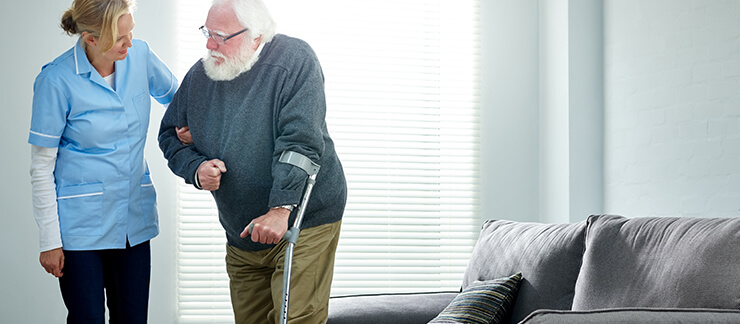
Elderly Fall Prevention: Spotting the Warning Signs & Risk Factors
Fall prevention is a crucial part of keeping elderly adults healthy and safe. Seniors are already at higher risk of suffering a fall, due to a range of age-related risk factors. When these falls occur, elderly adults face much a higher risk of serious injury. They also face a much lower likelihood of recovery from these injuries.
At Visiting Angels®, we help address these risks through our Safe & Steady Fall Prevention program. This program teaches seniors, families, and care providers how to make falls less likely by creating a safer home environment.
A big part of this program is learning how to spot warning signs and risk factors before falls happen. Even if you don’t think that your mom, dad, or grandparent is at high-risk right now, it’s a good idea to learn about these warning signs. That way, you can be proactive about fall prevention as soon as these signs appear.
Monitoring for Fall Prevention Warning Signs
Elderly adults’ increased risk of falls stems from a number of age-related issues. As we grow older, our strength, sense of balance, and eyesight decline, making falls more likely. We’re also at increased risk of conditions that can result in falls, such as diabetes or dementia. We’re also more likely to take medications, some of which have side effects that increase our risk of falling.
As these risk factors start to build up, seniors face every higher risk of suffering a fall. And if that happens, the results can threaten a senior’s living situation. In fact, falls are the number one reason that seniors lose their independence! Worse yet, falls are often life-threatening. A serious fall can result in a hip fracture, which can dramatically reduce life expectancy.
That’s why, at Visiting Angels, we recommend monitoring elderly loved ones for common warning signs and risk factors. This doesn’t mean you need to monitor your loved one constantly. But you should be keeping an eye out for:
- Signs that your loved one is at increased risk of falling
- Home hazards that could lead to a fall
Warning Signs & Risk Factors of Falls for Elderly Adults
When you’re looking for fall prevention warning signs and risk factors, you’ll want to keep an eye on two things: your loved one and your loved one’s home.
First, you’ll want to monitor for signs that your loved one is at increased risk of losing his or her balance. Some of the risk factors to watch for include:
- Muscle weakness or frailty
- Declining eyesight
- Change of hearing
- Uneven gait or poor balance when walking
- Injuries, stiffness, or pain in hips, knees, ankles, or feet
- Reliance on supports when walking, getting up, or sitting down
- Chronic physical conditions such as hypertension, diabetes, arthritis, or Parkinson’s
- Cognitive decline or impairment
- Prescription medications with side effects like dizziness, drowsiness, poor vision, poor balance, or muscle weakness
- Overuse of alcohol and/or abuse of narcotics
At the same time, you’ll want to look out for hazards that increase the risk of trips and slips at home. Try to keep an eye on areas with poor visibility, obstacles that could be tripped over, slippery surfaces, and areas with unsteady footing. In particular, be watchful of:
- Steps and stairways without handrails and/or proper lighting
- Steps and stairways with loose/unsecure handrails and/or steps
- Hallways and walkways without adequate nighttime lighting
- Loose wires, objects, or rugs that could be tripped over
- Bathroom or kitchen tile without non-slip tread
- Showers and bathtubs without non-slip tread
- Important items kept in high places
Remember, your loved one could be at risk of falling with only one or two of these risk factors present. So, don’t wait for several warning signs to build up before you take action. If you suspect your loved one is at risk of a fall, be proactive.
Fall Safety for the Elderly
If you suspect your elderly loved one is at risk of a fall, what next steps should you be taking? Broadly speaking, there are a number of avenues you can take.
For one thing, you can encourage your loved one to eat healthy foods and partake in regular exercise. Diet and physical activity will reduce the risk of your loved one losing his or her balance, plus countless other benefits.
At the same time, you can look at making fall prevention improvements to your loved one’s home. Simple changes like additional lighting, secure handrails, and less clutter can make a world of difference.
You might also want to think about having someone around your loved one more often. This might mean having family members visit more often, or it might mean hiring a caregiver. That way, someone will be there to lend support, reducing the risk of falls. And if a fall occurs, a bystander can ensure a quick response.
